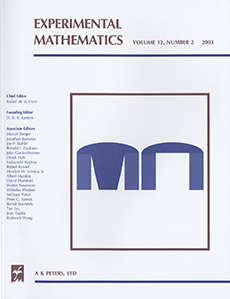Abstract
We investigate simple random walks on graphs generated by repeated barycentric subdivisions of a triangle. We use these random walks to study the diffusion on the self-similar fractal known as the Strichartz hexacarpet, which is generated as the limit space of these graphs. We make this connection rigorous by establishing a graph isomorphism between the hexacarpet approximations and graphs produced by repeated barycentric subdivisions of the triangle. This includes a discussion of various numerical calculations performed on these graphs and their implications to the diffusion on the limiting space. In particular, we prove that equilateral barycentric subdivisions—a metric space generated by replacing the metric on each 2-simplex of the subdivided triangle with that of a scaled Euclidean equilateral triangle—converge to a self-similar geodesic metric space of dimension log(6)/ log(2), or about 2.58. Our numerical experiments give evidence to a conjecture that the simple random walks on the equilateral barycentric subdivisions converge to a continuous diffusion process on the Strichartz hexacarpet corresponding to a different spectral dimension (estimated numerically to be about 1.74).
Citation
Matthew Begue. Daniel J. Kelleher. Aaron Nelson. Hugo Panzo. Ryan Pellico. Alexander Teplyaev. "Random Walks on Barycentric Subdivisions and the Strichartz Hexacarpet." Experiment. Math. 21 (4) 402 - 417, 2012.
Information




